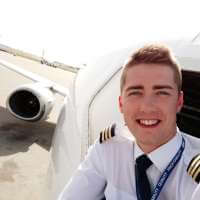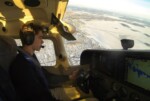Road to the Right Seat 11 – A New Phase
28 February 2017 | Updated on February 05, 2024
This post is part of the story series Road to the Right Seat.
We've all had a crazy childhood dream and mine was becoming an airline pilot. Many young people who aspire a flying career are unaware of the content of flight training and the preparations which are needed. On November 23rd, 2015 I started my ATPL(A) training. Time to realize my childhood dream. I'd like to take you along on an adventure and I'll happily answer all your questions on the way. Let's do this!
View all stories in this seriesApril 20, 2016 – Time flies when having fun, but I must admit it feels quite strange that we’re already one month into phase 2. We’ve now had all our new courses? which means I can give you an overview with some extra information!
The second phase still is a theoretical one, but the lesson content is more relatable to the practical sides of flying. We do a lot of exercises in class and we also have more free time to study. Our schedule seems more relaxed at the moment, but we’re all well aware that we’ll have to work hard until the end.
The books
- General Navigation
- Radio Navigation
- Air Law
- Flight Planning
- Mass and Balance
- Performance
- Operational Procedures


General Navigation:
GNAV is one of the biggest books to study in phase 2. We learn everything about charts, different ways to navigate and all the calculations we need to do so. An interesting and fun course!
Radio Navigation:
Everything you have to know about frequencies, radio waves, antennas and the application of these systems in aviation all around the world. It’s not my favorite course, but it’s not too difficult!
Air Law:
From the Chicago Convention in 1944 to separation minima overhead the Atlantic. Air Law is a very theoretical course and is everything but easy to study. My solution: study everything by heart and hope for the exam questions to be reasonable.
Flight Planning:
In this course, we learn about all the variables which have an effect on our flight. Winds, weight, weather, emergencies and so on… We make plenty of calculations using different graphs which I think is very useful.
Mass and Balance:
Bruce Dickinson explained us in a video how important it is to have good weight distribution in an airplane. You can find the video at the bottom of the page. M&B is a very short, but important course which we will apply for the rest of our lives.
Performance:
Take-off, climb, cruise, descent and landing are the main topics in this course. Here we also make use of many graphs to make performance calculations. I’d say this course is the follow-up of Principles of Flight, a course we had in Phase 1. These two are without a doubt my favorite courses.
Operational procedures:
The name explains everything already. We learn more about the operational aspect of flying and how we can improve safety as pilots. How do we deal with unforeseen circumstances and all the rules which apply to them? We’ll have to use a lot of the information from this book in our careers, making it a very important course.
If you have any further questions about my training, feel free to leave a comment below. See you next week!
This post is part of the story series Road to the Right Seat.
We've all had a crazy childhood dream and mine was becoming an airline pilot. Many young people who aspire a flying career are unaware of the content of flight training and the preparations which are needed. On November 23rd, 2015 I started my ATPL(A) training. Time to realize my childhood dream. I'd like to take you along on an adventure and I'll happily answer all your questions on the way. Let's do this!
View all stories in this series






























